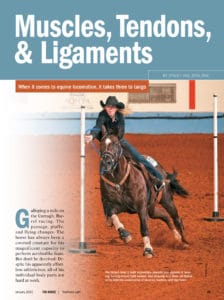Targeted Deworming Advocated for Cushing’s Horses
Horses with Cushing’s disease tend to have higher fecal egg counts than healthy horses.

Horses with Cushing’s disease tend to have higher fecal egg counts than healthy horses.
Horses recover from general anesthesia following removal of an eye (enucleation) equally well as horses recovering from other types of surgeries, reported veterinarians and surgeons who reviewed records of horses that underwent enucleation between 2006 and 2008. These horses were matched with similar aged horses undergoing surgery and general anesthesia. These cases included routine, elective proc
Cesarean sections, or C-sections, are performed on approximately 15%-25% of pregnant mares admitted to equine hospitals for dystocia (difficult or abnormal labor or delivery). C-sections are also performed as elective procedures or in cases where underlying medical or surgical conditions exist. To better establish the impact of C-sections on fertility and foaling rates in mares
A high prevalence of radiographic abnormalities exist in the joints of yearling and 2-year-old Quarter Horses, but the clinical significance of these changes is not yet known, according to Erin K. Contino.
Horses that recover from Lawsonia intracellularis infections cost less as yearlings than their siblings, but they race just as well. The bacterium L. intracellularis is the causative bacterial agent for equine proliferative enteropathy (EPE), which is characterized by diarrhea, depression, fever, inappetance (anorexia), weight loss, edema (fluid swelling) on the abdomen or lower limbs,

The horse’s body is both exceedingly powerful and capable of bending, turning around tight corners, and stopping on a dime, all thanks to his intricate combination of muscles, tendons, and ligaments.
Complications associated with equine castrations occur commonly and should be identified and treated properly in the field. A “Review of castration complications: Strategies for treatment in the field” was presented at the American Association of Equine Practitioners Convention.
Studies at both the molecular and cellular level are needed to better determine how tendon injuries occur, said a group of researchers in the United Kingdom. Only then can appropriate treatment and preventative measures be developed.
“Some tendons are more prone to injury than others; the majority of tendon injuries (97-99%) occur to the forelimb tendons, with the superficial
If horses and ponies undergo a carbohydrate overload when turned out onto lush, green pastures in the spring and endotoxemia occurs, then horses that are already insulin resistant may have increased risk of laminitis.
Osteoarthritis of the carpometacarpal joint (the lower joint space of the knee in a horse’s front leg) is a debilitating and life-threatening condition. However, surgically fusing the joint appears to be a viable treatment option in affected horses, say veterinary researchers and surgeons from the Western College of Veterinary Medicine in Saskatchewan, Canada. A retrospective
Chestnut coat color is not considered acceptable in some breeds of horses. A fast, cost-effective, and reliable method for the routine genotyping of alleles has been developed by Researchers from the Department of Genetics, Physical Anthropology and Animal Physiology at the University of the Basque Country in Bilbao, Spain.
Chestnut coat color is due to two recessive versions (
Surgery to correct “roaring” in National Hunt Thoroughbred racehorses can restore racing performance to levels similar to a matched group of peers in the short term, but career longevity appears to be negatively impacted following these procedures, report a team of UK researchers led by Safia Barakzai, BVSc, MSc, DESTS, Dipl ECVS, from the Royal (Dick) School of Veterinary Studies
Horses’ beauty in motion is achieved via the culmination of a complex and highly integrated interaction between muscles, tendons, ligaments, nerves, and a variety of other connective tissues. Successful coordination of all musculoskeletal system components is imperative for smooth, fluid, pain-free movement.
Equine veterinarians can now objectively monitor tendon healing using a technique called ultrasonographic tissue characterization (UTC), said researchers from The Netherlands.
While a number of novel therapies for tendon healing have been introduced recently, means of evaluating their clinical utility is difficult. Developed by Gerco Bosch, DVM, PhD, an assistant professor at Utre
A simple, noninvasive urine test to diagnose cryptorchidism in horses that appear to have been castrated has been developed by a group of researchers from the Racing Laboratory at the Hong Kong Jockey Club.
Male horses that appear or are presumed to be castrated can in fact have one or even two retained testicles. Retained testes should be removed to help eliminate objectionable b
While many veterinarians have long suspected that infected joints from which bacteria can be cultured result in a poorer outcome than horses from which no bacteria could be cultured, this hypothesis was recently substantiated by a group of United Kingdom researchers led by Tim Mair, BVSc, MRCVS, DEIM, DESTS, Dipl. ECEIM, of the Bell Equine Veterinary Clinic.
Infections of synovial
Stay on top of the most recent Horse Health news with